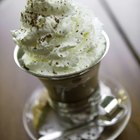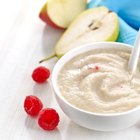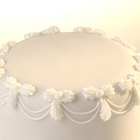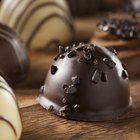
You don't have to use any type of sweetener in your whipped cream, although many cooks and dessert-lovers wouldn't consider such a thing. Whipped cream adds a dimension that just isn't there otherwise, and homemade whipped cream makes it even more luxurious, once you get the technique down. As for those sweeteners you don't need but don't want to do without, there's a bit of science involved when making your decision.
Argument for Powdered Sugar
When you are looking for instructions on how to make sweetened homemade whipped cream, you will see powdered sugar or confectioners sugar as the sweetener of choice, more often than not. Powdered sugar has a finer texture than granulated sugar and dissolves into the cream more easily for a smoother texture, but that isn't the only reason. Powdered sugar also helps homemade whipped cream hold its shape, because it has a small amount of cornstarch in it, which is a natural whipped cream stabilizer.
The Choice Is Yours
Although powdered sugar tends to work well in whipped cream, you can use granulated sugar if that's all you have, or if you prefer it for some reason. If you use granulated and it seems that your whipped cream isn't as stable as you'd like, you can add about 1 tablespoon of cornstarch for each 1 cup of cream to help firm it. You can also try maple syrup, or a combination of sweeteners if you're looking for a different taste or texture. Vanilla, cocoa powder and various liqueurs are also acceptable flavorings for homemade whipped cream.
Multiple Uses
A sweet, cushiony pillow of whipped cream has a home in scores of different dessert creations. Whipped cream makes a suitable topping for cakes, custards, pies, fruit salads, ice cream sundaes or banana splits, as well as drinks like hot chocolate or coffee beverages. Whipped cream goes well with strawberry shortcake, mousses, puddings and pastries. Whether you prefer a small dollop or a heaping mound, virtually any sweet treat becomes elevated when whipped cream enters the picture.
Extra Tips
Regardless of the type of sweetener you decide to use, transforming liquid cream into whipped cream requires some technique and is accomplished easier when you keep some basic tips in mind. Keep the cream as cold as you can before whipping, and use a chilled metal bowl for optimum results. If you can chill the whisk or beaters, that is also a good idea. Start off slowly with the beating to minimize splatters and increase the speed as it thickens. If you use powdered or granulated sugar, add it after the cream has formed soft peaks so it doesn't lose volume, but stop beating after stiff peaks are formed or you'll risk making sweetened butter.
Related Articles

How to Know When Handmade Whipping ...

How to Make Whipped Frosting Without ...
Cream vs. Creamer

Calories in a Tablespoon of Cream Cheese

Adding Vanilla Pudding to Whipping Cream

Can You Make Ice Cream with Lactose ...
How Can I Prepare Whipping Cream Ahead ...

How to Make Chocolate Ganache With ...
What Do Bakeries Use in Their Whipped ...
Differences in Half & Half Vs. Cream ...

How to Make Stiff Peaks in Whipped Cream

How to Make Homemade Moisturizing Cream ...

How Many Calories Are in Cream of Wheat?

How to Make Classic Eggnog (with ...

How to Make a White Decorator Icing
A Substitute for Meringue

Vegan Sour Cream Substitutes

What Does Stabilizing Frosting Mean?

Calories in Dark Chocolate Truffles

Heavy Whipping Cream Vs. Half & Half
References
Writer Bio
Joshua McCarron has been writing both online and offline since 1995. He has been employed as a copywriter since 2005 and in that position has written numerous blogs, online articles, websites, sales letters and news releases. McCarron graduated from York University in Toronto with a bachelor's degree in English.
Photo Credits
Ablestock.com/AbleStock.com/Getty Images